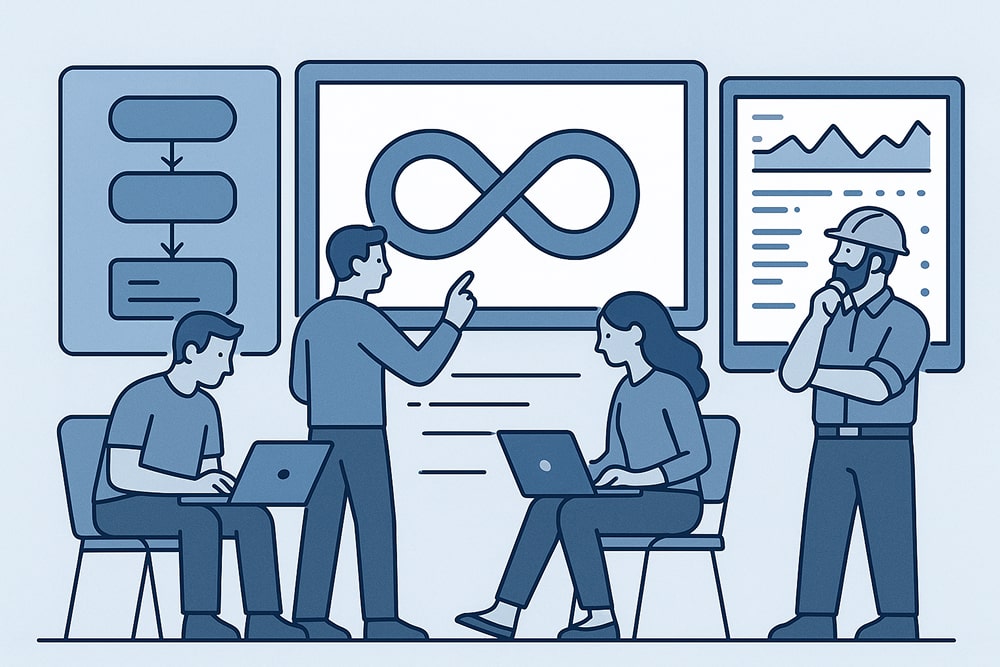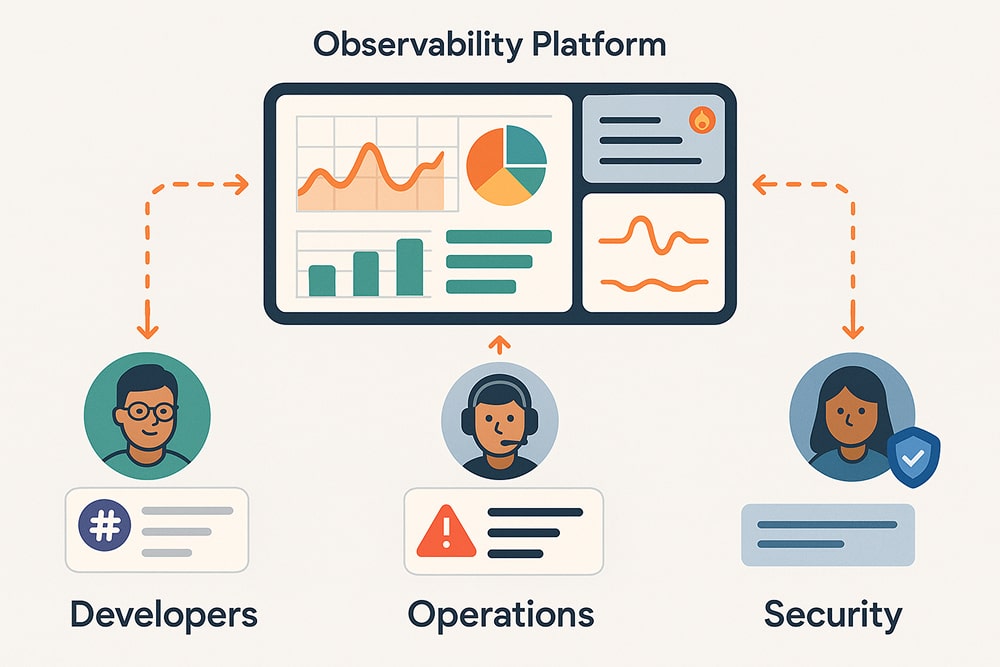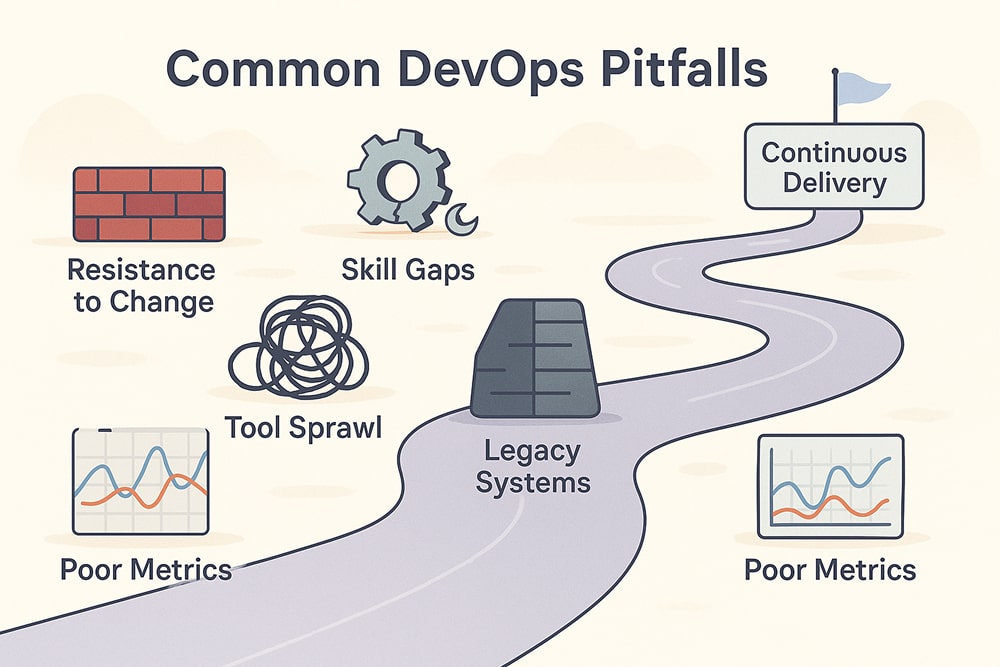Release cycles for modern software are measured in days, not months. Users want new features, security updates, and performance improvements as soon as possible. Stage-gate workflows that move code from development to operations in a straight line create bottlenecks, increasing the likelihood of defects in production.

That’s why more and more businesses are putting a clear DevOps transformation plan into action: it brings together people, processes, and tools so that code can move smoothly from idea to production.
In short, DevOps enables engineering teams to deliver reliable software at the speed required by today’s digital market, without compromising security or stability.
What Is DevOps Transformation?
DevOps transformation is the shift from siloed development and operations to a single, streamlined workflow that supports continuous delivery and small, safe releases that reach users quickly.
Why DevOps matters today
- Automation everywhere: Build, test, deploy, and even security checks run without manual steps.
- Shared culture: Developers, ops, QA, and security own the same goals and metrics, not separate hand-offs.
- Unified toolchain: Version control, CI/CD, monitoring, and incident response are connected, so data flows both ways.
- Fast feedback loops: Real-time metrics from production feed directly into code improvements.
Together, these changes reduce release risk, speed up delivery, and give teams a single view of product health.
Step-by-Step DevOps Transformation
The seven steps below outline a straightforward path from ad-hoc releases to reliable, automated delivery.
Step 1 - Build Your Roadmap

Document the real bottlenecks first, then translate them into short, timed objectives.
- Capture baseline DORA metrics (lead time, deployment frequency, change-failure rate, MTTR) for one flagship service.
- Map each delay: hand-offs, environment setup, flaky tests, and manual approvals.
- Classify work as quick wins (two-sprint items like adding a linter) or strategic (quarter-scale items such as breaking a monolith).
- Write 30-, 60-, and 90-day checkpoints in a version-controlled roadmap.yaml and link to Jira epics.
- Launch a one-team pilot; run a retro after the first sprint, and update the roadmap with lessons.
Outcome: Everyone sees the plan, metrics are baseline, and small wins fund the next stage.
Step 2 - Modernize Infrastructure
Move workloads onto predictable, self-healing platforms so environments stop drifting.
- Adopt a managed Kubernetes service (EKS, AKS, or GKE). Enable Cluster Autoscaler to automatically match load.
- Build minimal distroless images and scan them in CI with Trivy.
- Store Terraform or Pulumi code in Git; merge only after the Terraform plan passes review. Apply GitOps: Argo CD or Flux reads manifests in /clusters/<env> and reconciles the cluster state.
- Use OPA Gatekeeper to block misconfigurations. Example constraint:
apiVersion: constraints.gatekeeper.sh/v1beta1 kind: K8sRequiredLabels metadata: name: namespaces-must-have-team spec: match: kinds: - apiGroups: [""] kinds: ["Namespace"] parameters: labels: ["team"]
Targets: Cluster bootstrap in <5 min; nightly config drift <3 percent.
Step 3 - Automate the Delivery Pipeline
Turn every commit into a tested, versioned artifact that rolls forward or back without manual work.
- Follow trunk-based development; keep feature branches under 24 hours.
- Run build, unit tests, lint, and software-composition analysis on each push.
- Tag images with the Git SHA and push to the registry.
- Use Argo Rollouts (or Flagger) for 20 → 40 → 100 percent canaries; auto-rollback above a 2 percent error spike.
- Add integration tests (Testcontainers), end-to-end checks (Playwright), and load tests (k6).
Minimal CI job: name: ci on: [push] jobs: build: runs-on: ubuntu-latest steps: - uses: actions/checkout@v4 - uses: actions/setup-go@v5 with: {go-version: "1.22"} - run: go test ./... -coverprofile=cover.out - run: docker build -t ghcr.io/org/api:${{ github.sha }} . - uses: aquasecurity/trivy-action@v0.22 with: {image-ref: ghcr.io/org/api:${{ github.sha }}
KPI: ≥5 production deploys per day; MTTR ≤30 minutes.
Step 4 - Strengthen Collaboration & Culture
Give every role the same objectives and visibility.
- Establish a shared on-call rotation; display schedules in PagerDuty.
- Post each deployment to #deploys in Slack; add a /rollback <hash> command.
- Include Ops and Security in sprint planning, reviews, and retrospectives.
- Publish blameless post-mortems within 48 hours; track actions to closure.
- Survey psychological safety each quarter and address issues quickly.
When developers carry the pager and Ops join code reviews, incentives align.
Step 5 - Enhance Observability & Feedback

Collect actionable data, alert early, and feed findings back into sprints.
- Export metrics with Prometheus; store a year of history in Thanos.
- Define SLOs in Sloth; alert on error-budget burn, not raw failures.
- Stream JSON logs via Fluent Bit to Loki; keep p95 search latency <3 seconds.
- Instrument traces with OpenTelemetry and send to Tempo; sample 100 percent on error conditions.
- Attach runbook links to every Grafana OnCall alert so responders know the next step.
These signals drive backlog items for resilience and performance, eliminating the need for guesswork.
Step 6 - Integrate Security (DevSecOps)
Bake security into the same pipeline that runs tests.
- Scan code with Semgrep; block merges on critical rules.
- Scan images and third‑party libraries with Trivy or Grype; fail builds if CVSS ≥8.
- Inject secrets at runtime with Vault Agent; remove plaintext secrets from Git.
- Sign images with Sigstore Cosign and verify in a Kubernetes admission controller.
- Run InSpec profiles nightly to confirm SOC 2 controls.
Security moves left, risk drops, and audit evidence lives in Git.
Step 7 - Scale & Continuously Improve
Systematize the gains and keep learning.
- Deploy Backstage to enable engineers to scaffold a service with CI, CD, and monitoring in under five minutes.
- Schedule weekly chaos tests (Litmus or Gremlin); aim for automatic recovery under two minutes.
- Wrap new code in feature flags (Flagd or LaunchDarkly) and release based on live metrics.
- Track cost and carbon with Kubecost; alert when a namespace exceeds $500 per month.
- Run quarterly game days; update the roadmap with new priorities.
These loops-self-service, chaos, feature flags, cost checks, and game days-keep the platform healthy and evolving long after the initial DevOps transformation plan is complete.
Common Pitfalls to Avoid

- Resistance to change: Teams don’t want to change when they don’t see the benefits. To keep the momentum going, share early successes (like shorter build times), get skeptics involved in pilot projects, and get visible support from executives.
- Skill gaps: You need to practice with new tools like Kubernetes, Terraform, and Prometheus. Create a skills matrix, conduct hands-on workshops, pair less experienced engineers with mentors, and allocate time for learning within the sprint capacity.
- Tool sprawl: Overlapping products create confusion and maintenance overhead. Set up a reference toolchain, connect it through open APIs, and check its usage every three months. Remove anything unnecessary, following a clear plan for when to do so.
- Legacy monoliths: Large, tightly coupled codebases slow tests and releases. Apply the strangler-fig pattern: carve out one slice behind an API, migrate it to a microservice with full test and observability coverage, then repeat.
- Poor metrics: Vanity stats hide real progress. Track DORA metrics (deployment frequency, lead time, MTTR, change-failure rate) and user-facing SLOs instead. Display dashboards in a shared space and review trends every sprint.
FAQs
Q1. What common obstacles derail DevOps transformation efforts?
Limited automation, fragmented toolchains, and legacy infrastructure typically slow progress. Start small, celebrate wins, and secure leadership buy-in.
Q2. How do you measure success in a DevOps transformation roadmap?
Track North-Star metrics: deployment frequency, lead time for changes, MTTR, and change failure rate. Improvement across these indicates healthier flow.
Q3. When is it time to adapt your DevOps strategy roadmap?
Re-evaluate quarterly or sooner if KPIs don’t progress, business priorities shift, or new regulations emerge.
Q4. How should teams decide which DevOps tools to use first?
Find the places where things go wrong (like slow builds). Test one tool that fixes the biggest problem, demonstrate its effectiveness, and then add more.
Q5. What effect does DevOps transformation have on the culture and teamwork of the team?
It encourages shared ownership, learning without blame, and faster feedback, which breaks down the barriers between Dev and Ops.
Conclusion
A disciplined DevOps journey delivers speed with stability. By following this step-by-step framework, tracking outcome-based metrics, and promoting continuous learning, engineering teams can modernize software delivery and lower operational risk. When additional expertise is required, partnering with experienced DevOps transformation services helps accelerate progress and sustain momentum.


